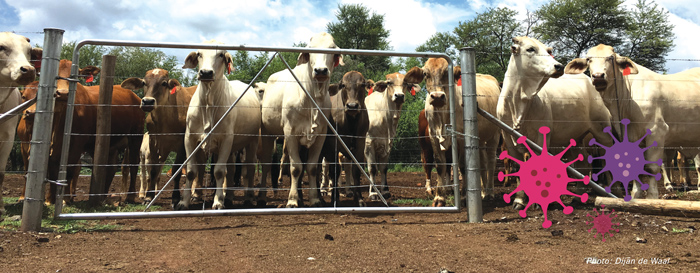July 2023

Foot-and-mouth disease (FMD) is a severe, highly contagious viral disease among livestock that has a significant economic impact. The disease affects cattle, pigs, sheep, goats and other cloven-hoofed ruminants.
The FMD is estimated to circulate in 77% of the global livestock population in Africa, the Middle East and Asia, as well as in a limited area of South America.
The FMD virus is vulnerable to extremes in the pH. Both acids (such as citric acid) and bases (such as caustic soda or sodium hydroxide) can destroy the virus. However, to be effective, these disinfectants must be applied properly – in the right concentration and at the right temperature – and must remain in direct contact with the target surface for a sufficient time. Before applying a disinfectant, the surface must free of dirt, dust, manure, mud and other debris.
CLEAN
The goal is to remove as much debris as possible. Such material can shield contaminants from the action of chemical disinfectants. Pre-cleaning is also important because many disinfectants are less potent in the presence of organic material. Scrape, brush or sweep the surface to remove all solids (dirt, feed, manure, bedding and other debris). If it is dusty, moisten the area to control dust and minimise aerosolization.
Proper disposal of solid waste, dirt, bedding, manure and other organic material is important. Local regulations may require burning, burial or composting. Personnel should wear protective clothing (for example, gloves, face masks, goggles or headwear) and rubber boots.
WASH
Try to reduce the number of contaminants on the surface as much as possible. Soak surfaces with water and detergent or another cleaning agent. Then wash the surfaces by spraying, wiping or scrubbing. Steam and high-pressure washers (200 psi to 1 000 psi) can be useful, especially for cleaning porous surfaces. A washing solution can also be applied with a simple, low-pressure (90 psi to 120 psi) garden hose applicator.
Proceed from the cleanest areas to the dirtiest and from the highest level (ceiling) to the lowest (floor). Equipment that can be removed, should be brushed and soaked in detergent before disinfection. Hoses, connectors, troughs or drains can serve as reservoirs for pathogens and should be cleaned last.
After washing, thoroughly rinse all surfaces at a low pressure to remove any residue. Some disinfectants (i.e., hypochlorite) can be inactivated by soaps and detergents. To reduce the risk of excess dilution of the disinfectant, areas should be allowed to drain or dry before application. Use extra care in high-pressure spraying to minimise spreading contaminants via aerosolization. Personnel should wear protective clothing (e.g., gloves, face masks, goggles or headwear) and rubber boots.
DISINFECT
The goal is to deactivate the remaining FMD virus. Read the entire product label and follow the instructions carefully to ensure that the application is as safe and effective as possible.
Be sure to:
Publication: July 2023
Section: Pula/Imvula
Author: RPO BULLETIN, APRIL 2023